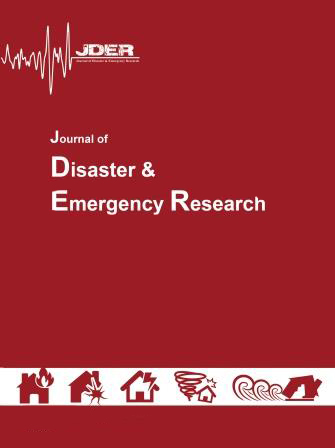1.Baur E, Parker M. Building financial resilience-the role of risk transfer for sovereign disaster risk management. Planet@ risk. 2015;3(1).
2.Natural catastrophe losses at their highest for four years [Internet]. Munich RE. 2017.
3.Emerging countries affected by insurance gaps [Internet]. Munich RE. 2013. Available from: https://www.munichre.com/topics-online/ en/ climate- change- and- natural- disasters/ resilience/ emerging- countries- natural- catastrophies- insurance- gap. html.
4.OECD. Disaster Risk Financing: A global survey of practices and challenges. OECD Publishing, Paris, 2015.
5. Le Quesne F, Tollmann J, Range M, Balogun K, Zissener M, Bohl D, et al. The role of insurance in integrated disaster & climate risk management: Evidence and lessons learned. Institute for Environment and Human Security, United Nations University, 2017.
6.Warner K, Ranger N, Surminski S, Arnold M, Linnerooth-Bayer J, Michel-Kerjan E, et al. Adaptation to climate change: Linking disaster risk reduction and insurance. Geneva, Switzerland: United Nations International Strategy for Disaster Reduction, 2009.
7.Quarantelli EL, editor Catastrophes are different from disasters: Some implications for crisis planning and managing drawn from Katrina. Online forum and essays]–Social Science Research Council; 2005: Citeseer.
8.GOI. Disaster Management in India - A Status Report. National Disaster Management Division, Ministry of Home Affairs, Government of India; 2004.
9.Wallemacq P, House R. Economic Losses, Poverty and Disasters 1998–2017. Brussels: CRED and UNISDR, 2018.
10.FICCI. India General Insurance “Vision 2025” Towards an inclusive, progressive and high performing sector. FICCI, 2013.
11.Sylvester A, Tate M, Johnstone D. Beyond synthesis: re-presenting heterogeneous research literature. Behaviour & Information Technology. 2013;32(12):1199-215.
12. Cronin P, Ryan F, Coughlan M. Undertaking a literature review: a step-by-step approach. British journal of nursing. 2008;17(1):38-43.
13.Mechler R, Linnerooth-Bayer J, Peppiatt D. Disaster Insurance for the Poor? A review of microinsurance for natural disaster risks in developing countries. ProVention Consortium, 2006.
14.Bhat S, Mukherjee P. Towards de-risking disasters: Taking stock of microinsurance
for disaster risk reduction–index based microinsurance in South and South East Asia. Lucknow, India: MicroSave, 2013.
15.GFDDR, World Bank Group. Financial Protection against Natural Disasters: From Products to Comprehensive Strategies An Operational Framework for Disaster Risk Financing and Insurance. Washington D.C, USA: World Bank, 2014.
16.Sobel RS, Leeson PT. Government's response to Hurricane Katrina: A public choice analysis. Public Choice. 2006;127(1-2):55-73.
17.Schneider SK. Administrative breakdowns in the governmental response to Hurricane
Katrina. Public Administration Review. 2005; 65(5):515.
18.ESCAP, IDD. Financing Disaster Risk Reduction for Sustainable Development in Asia and the Pacific. Third International Conference on Financing for Development; Addis Ababa, Ethiopia: ESCAP; 2015.
19.Gulati A, Terway P, Hussain S. Crop Insurance in India: Key Issues and Way Forward. New Delhi, India: Indian Council for Research on International Economic Relations, 2018.
20.GOI. Report of the Committee to Review the Implementation of Crop Insurance Schemes in India. Department of Agriculture & Cooperation, Government of India; 2014.
21.GOI. Pradhan Mantri Fasal Bima Yojana. Ministry of Agriculture & Farmers Welfare, Government of India; 2016.
22.BAROT JK. Study of Indian Livestock Insurance Sector. International Journal of Research in Humanities & Social Sciences. 2015;3(4):52-9.
23.Urech E, Patankar M, Winter P, Singh P, Welten P, Mu S, et al. Closing the insurance gap for livestock. Zurich: Swiss Reinsurance Company Ltd, 2017.
24.ILO. Insurance products provided by insurance companies to the disadvantaged groups in India. Geneva, Switzerland: International Labour Office, 2005.
25.FICCI. India General Insurance “Improving penetration & driving market creation". FICCI, 2014.
26.IRDAI. Handbook on Life Insurance. Insurance Regulatory and Development Authority, Government of India: 2012.
27.Roth J, Ramm G. Microinsurance: Demand and Market Prospects –India. Allianz AG, GTZ and UNDP, 2006.
28.GOI. Pradhan Mantri Jeevan Jyoti Bima Yojana. Department of Financial services, Ministry of Finance, Government of India; 2015a.
29.GOI. Pradhan Mantri Suraksha Bima Yojana. Department of Financial services, Ministry of Finance, Government of India; 2015b.
30.Garand D. CGAP Working Group on Microinsurance: Good and Bad Practices in Microinsurance. India: VimoSEWA, 2005.
31.Bhatt MR, Pathak V. Risk Transfer through Microinsurance: Lessons Learnt and Evidence from Phailin Cyclone Affected Community. All India Disaster Mitigation Institute (AIDMI) and UNISDR, 2015.
32.Gupta S, Agrawal R. Micro-insurance for Disaster Management@ A Case of Afat Vimo in Orissa. Journal for Studies in Management and Planning. 2015;1:220-6.
33.Kaur J. Insurance Penetration and Density in India. International Journal Of Business Management. 2015;2(1):765-70.
34.Kalal AD, Gajja NG. Growth of Insurance in Rural Areas. IOSR Journal of Business and Management. 2017:12-7.
35.IMF. Technical Note on Insurance Sector Regulation and Supervision. Washington D.C., USA: International Monetary Fund, 2018.
36.Iips I. National Family Health Survey (NFHS-4), 2015–16. International Institute for Population Sciences (IIPS), Mumbai, India. 2017.
37.Four reasons why Indians buy such little general insurance [Internet]. Livemint. 2018. Available from: https://www.livemint.com/ Opinion/ mZXybE4ywQZQag12KzY7TO/Four-reasons-why- Indians-buy-such- little- general-insurance. html.
38.Rao N, Periyasamy S. Life Insurance Penetration in Rural Areas-Indian Perspective. International Journal of Banking, Risk and Insurance. 2014;2(2):21.
39.Sahu P. Govt insurance schemes: Claim ratio reached up to 170% in FY-17. Indian Express. 2017. Available from: https://indianexpress.com/ article/ business/business-others/pmjjby-govt-insurance-schemes-claim-ratio-reached-up- to-170- per-cent-in-fy17/
40.Patel SK, Agrawal G, Mathew B, Patel S, Mohanty B, Singh A. Climate change and women in South Asia: a review and future policy implications. World Journal of Science, Technology and Sustainable Development. 2019;17(2):145-66.
41.Patel SK, Mathew B, Nanda A, Mohanty B, Saggurti N. Voices of rural people: Community-level assessment of effects and resilience to natural disasters in Odisha, India. International Journal of Population Studies. 2020;6(1):3-15.
42.Sharma R, Hochrainer-Stigler S, Mechler R. Impact assessment of disaster microinsurance for pro-poor risk management: Evidence
from South Asia. All India Disaster Management Institute and ProVention Consortium, 2011.
43.Nair R. Crop insurance in India: changes and challenges. Economic and Political weekly. 2010:19-22.
44.ACT. Climate Risk Insurance: Assessing the Market for Climate Risk Insurance in Guwahati within a Climate and Disaster Risk Management Framework. Action on Climate Today, 2017.

